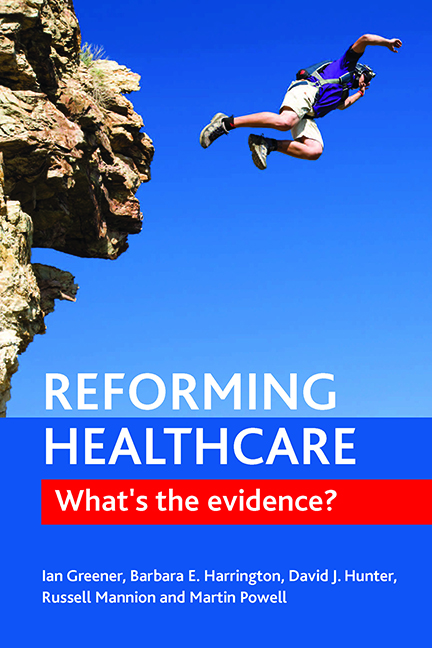Book contents
- Frontmatter
- Contents
- List of tables
- Acknowledgements
- one Introduction
- two The NHS in 1990
- three Reorganising the NHS, 1990–2010
- four ‘Central control’ reorganisation in the NHS in the 2000s
- five Local dynamic reform in the NHS since 2000
- six The prospects for NHS reorganisation post-2010
- seven Conclusion
- References
- Index
two - The NHS in 1990
Published online by Cambridge University Press: 25 February 2022
- Frontmatter
- Contents
- List of tables
- Acknowledgements
- one Introduction
- two The NHS in 1990
- three Reorganising the NHS, 1990–2010
- four ‘Central control’ reorganisation in the NHS in the 2000s
- five Local dynamic reform in the NHS since 2000
- six The prospects for NHS reorganisation post-2010
- seven Conclusion
- References
- Index
Summary
Introduction
The aim of this chapter is to provide the context for the rest of the book, exploring the NHS in 1990 in terms of its organisational structure and dynamics at that time. In an institution like the NHS, where understanding history is important to get a sense of why particular structures were put in place or what kinds of relationships exist between policy-makers and staff, this necessarily involves going back before 1990. However, we attempt to include only the elements of NHS history that are most relevant to understanding the material in the rest of the book.
The chapter proceeds by presenting the background to health organisation and policy in 1990 to provide a starting point for the account of subsequent reorganisations, exploring in more depth attempts at reorganisation during the 1980s (especially the Griffiths management reforms and the Working for patients internal market) in order to construct the ‘shared version’ of health politics in 1990s which provides the starting point, and context, for the book's analysis.
Background
The central organisational relationship in health policy and politics in the first decades of the NHS was that which existed between the state (broadly speaking, the government of the day) and the medical profession. Klein (1990) captures the relationship in characteristically vivid terms as being a ‘double bed’ of mutual dependence, with the medical profession dependent on the state which was effectively the monopoly employer of their services (outside of a very small private sector), and the state, at the same time, dependent on the medical profession to both run the NHS, and to ration its care within the resources available. Although the relationship was one of dependence, that did not mean that conflict could not occur or even become public (as it certainly did during negotiations over medical contracts in the 1960s and during industrial disputes in the 1970s), but it did mean that both the state and the medical profession had little alternative but to try and work with one another to make the best of the situation.
The period 1948–81 was, in retrospect, one of remarkable continuity and relative calm in respect of NHS organisation and policy.
- Type
- Chapter
- Information
- Reforming HealthcareWhat's the Evidence?, pp. 11 - 28Publisher: Bristol University PressPrint publication year: 2014



